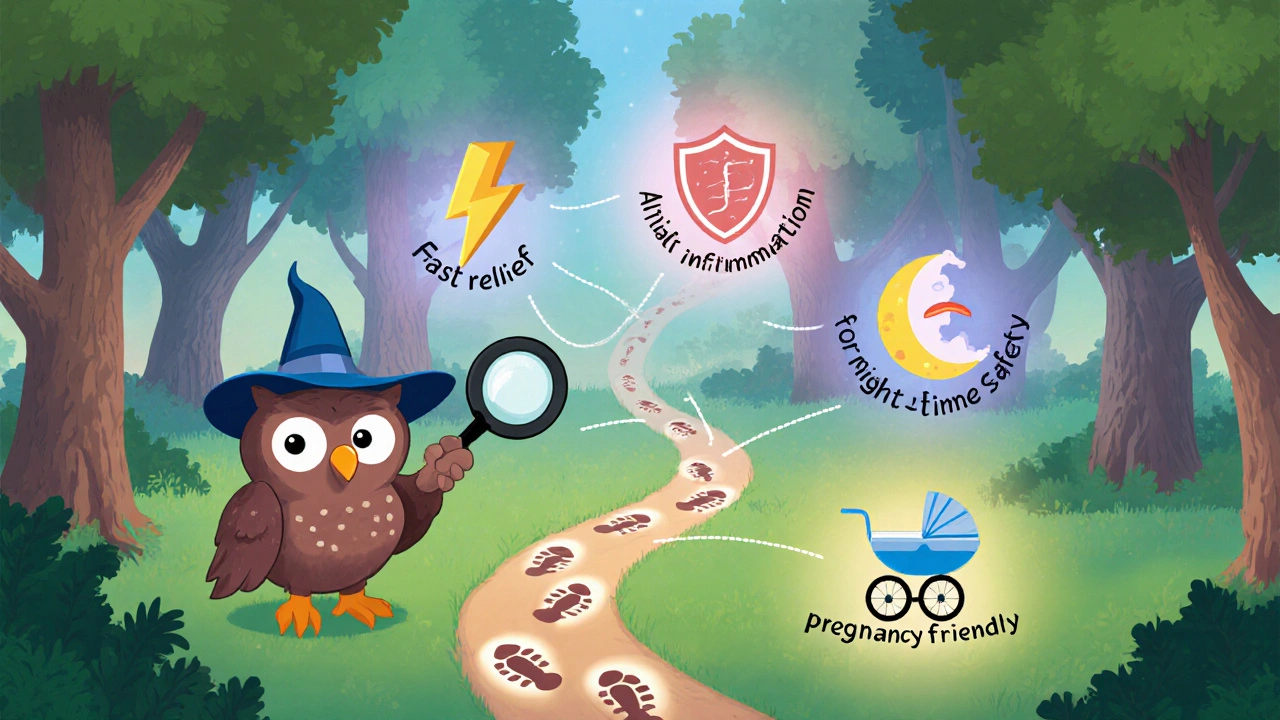When a throbbing headache or a sore muscle strikes, most of us reach for an over‑the‑counter (OTC) pill without thinking twice. But not all pain relievers are created equal, and the right choice depends on the type of pain, how quickly you need relief, and how your body reacts to certain ingredients. This guide breaks down Anacin alternatives and shows you when Anacin’s aspirin‑caffeine blend shines-or falls short-against the market’s most popular options.
What Is Anacin?
Anacin is a classic OTC analgesic that combines aspirin (325mg) with caffeine (32mg) per tablet. The aspirin works as a non‑steroidal anti‑inflammatory drug (NSAID) to reduce inflammation and pain, while caffeine enhances pain‑relief pathways and speeds up absorption. Typically sold in 2‑tablet doses, Anacin is marketed for headaches, minor muscle aches, and fever.
Key Attributes to Compare
- Active ingredients: Determines mechanism of action and potential drug interactions.
- Onset of relief: How fast you start feeling better.
- Duration: How long the effect lasts.
- Target pain type: Headache, joint pain, menstrual cramps, etc.
- Side‑effect profile: Gastro‑intestinal upset, bleeding risk, drowsiness, etc.
- Price range (AU$): Typical retail cost for a standard pack.
Popular Alternatives
Below are the most common OTC products people consider when looking for an Anacin substitute.
Excedrin combines acetaminophen (250mg), aspirin (250mg), and caffeine (65mg) per tablet, targeting tension‑type headaches and migraines.
Advil contains ibuprofen 200mg per tablet, an NSAID that excels at reducing inflammation from sprains and arthritis.
Aleve provides naproxen sodium 220mg per tablet, a longer‑acting NSAID often chosen for back pain.
Tylenol (acetaminophen) 500mg per tablet, a pain reliever without anti‑inflammatory properties, favored by those who can’t tolerate NSAIDs.
Bayer Aspirin is plain aspirin 325mg per tablet, the pure NSAID baseline for many heart‑health regimens.
Motrin (ibuprofen) 200mg per tablet, similar to Advil but marketed with a focus on pediatric dosing.
Midol blends acetaminophen, caffeine, and pyrilamine to tackle menstrual cramps and associated headaches.
Benadryl Pain (diphenhydramine + acetaminophen) offers mild sedation alongside pain relief, useful for nighttime aches.
Side‑by‑Side Comparison
| Product | Key Ingredients | Onset | Duration | Best For | Typical AU$ Price | Notes |
|---|---|---|---|---|---|---|
| Anacin | Aspirin 325mg + Caffeine 32mg | 15‑30min | 4‑6hr | Headache, minor muscle aches | 5‑7 for 20‑tablet pack | May irritate stomach; avoid if on blood thinners. |
| Excedrin | Aspirin 250mg + Acetaminophen 250mg + Caffeine 65mg | 10‑20min | 4‑6hr | Migraines & tension headaches | 7‑9 for 12‑tablet pack | Higher caffeine; not for pregnant women. |
| Advil | Ibuprofen 200mg | 20‑40min | 6‑8hr | Inflammatory pain (sprains, arthritis) | 6‑8 for 24‑tablet pack | Safe with alcohol in moderation; watch kidney health. |
| Aleve | Naproxen Sodium 220mg | 30‑45min | 8‑12hr | Back pain, menstrual cramps | 8‑10 for 12‑tablet pack | Longest lasting OTC NSAID; higher GI risk. |
| Tylenol | Acetaminophen 500mg | 30‑60min | 4‑6hr | Fever, mild to moderate pain | 5‑7 for 20‑tablet pack | No anti‑inflammatory effect; safe for most stomach‑sensitive users. |

Pros and Cons of Anacin
- Pros
- Fast‑acting thanks to caffeine boost.
- Combination tackles both pain pathways (COX inhibition + central stimulation).
- Relatively inexpensive.
- Cons
- Stomach irritation common; not ideal for ulcer‑prone patients.
- May increase bleeding risk when paired with anticoagulants.
- Caffeine can cause jitteriness or interfere with sleep.
When to Choose an Alternative
- Long‑lasting relief needed: Opt for Aleve’s naproxen, which can cover you through a night shift or a long travel day.
- Inflammation is the primary issue: Ibuprofen‑based products (Advil, Motrin) target swelling better than aspirin‑caffeine combos.
- Pregnancy or breastfeeding: Stick with acetaminophen‑only options like Tylenol, as NSAIDs can affect fetal development.
- Stomach‑sensitive users: Avoid all aspirin or NSAID blends; choose Tylenol or a buffered aspirin formulation.
- Migraine sufferers: Excedrin’s triple‑action formula (acetaminophen + aspirin + caffeine) often outperforms single‑ingredient pills.
How to Use Anacin Safely
- Never exceed two tablets (650mg aspirin) in a 24‑hour period unless a doctor advises otherwise.
- Take with food or a full glass of water to reduce gastric irritation.
- Check other medications - many cold remedies already contain caffeine or aspirin.
- If you have a history of ulcers, heart disease, or are on blood‑thinners, consult a pharmacist before use.

Quick Decision Guide
Use this flow‑chart‑style checklist to pick the right product in under a minute:
- Do you need fast relief for a headache? - Yes → Consider Anacin or Excedrin. No → Go to step 2.
- Is inflammation (swelling, joint pain) a major factor? - Yes → Choose Advil, Motrin, or Aleve.
- Are you pregnant, nursing, or have a sensitive stomach? - Yes → Pick Tylenol or a buffered aspirin.
- Do you want coverage for 8‑12 hours without re‑dosing? - Yes → Aleve is the best fit.
- Do you need a nighttime option that won’t keep you awake? - Yes → Tylenol or Benadryl Pain.
Common Mistakes to Avoid
- Mixing multiple NSAIDs (e.g., Anacin + Advil) - this doubles GI risk.
- Taking caffeine‑heavy combos late in the day - can sabotage sleep.
- Relying on the same product every day for chronic pain - may mask underlying issues and increase side‑effects.
Bottom Line: Which One Wins?
If you’re looking for a quick, inexpensive solution for a mild to moderate headache and you tolerate aspirin well, Anacin remains a solid choice. However, if you need longer coverage, have inflammation, or must avoid caffeine, an alternative like Advil, Aleve, or Tylenol will likely serve you better. Keep the decision criteria in mind, watch for contraindications, and you’ll avoid the trial‑and‑error cycle most of us have endured at the pharmacy aisle.
Frequently Asked Questions
Can I take Anacin with coffee?
Yes, but be mindful of total caffeine intake. Anacin already contains 32mg of caffeine, so an extra cup of coffee (≈95mg) may push you toward jitters or insomnia, especially if you’re sensitive.
Is Anacin safe during pregnancy?
Most healthcare providers advise against regular aspirin use in pregnancy because it can affect fetal blood flow. Talk to your obstetrician before taking Anacin, especially in the third trimester.
How does Anacin compare to Excedrin for migraines?
Excedrin adds acetaminophen to the mix, giving three mechanisms of action (COX inhibition, central pain reduction, caffeine boost). For many migraine sufferers, this translates to faster relief and fewer recurrences than Anacin’s two‑ingredient formula.
What should I do if I experience stomach pain after taking Anacin?
Stop using the product and take it with food or an antacid. If pain persists or you notice vomiting blood, seek medical attention promptly.
Can I combine Anacin with a prescription NSAID?
Combining two NSAIDs (like aspirin in Anacin with ibuprofen) raises the risk of gastrointestinal bleeding and kidney strain. Always discuss with your doctor before mixing OTC and prescription pain meds.

Roger Cardoso
October 15, 2025 AT 18:17Everyone pretends they’re choosing the cheapest analgesic, but the real story is that Big Pharma wants us glued to their endless supply of caffeine‑laden pills. Anacin looks innocuous, yet it’s a gateway drug engineered to keep you dependent on that jittery buzz. If you skim the fine print, you’ll notice the same conglomerates behind the aspirin‑caffeine combo also fund anti‑inflamation campaigns. So next time you reach for the bottle, ask yourself who profits from your headache.
Kristen Holcomb
October 18, 2025 AT 01:50Hey folks, just a quick heads‑up-always take Anacin with a solid snack or a glass of water. It can really cut down on that gnawing cafeine‑induced stomach ache. If you’ve got a sensitive stomach, consider a buffered aspirin or grab a little yogurt before you pop the pill. Stay safe out there!
justin davis
October 20, 2025 AT 09:24Wow-because nothing says “I’m ready for a productive day” like a 30‑minute caffeine crash!!! Anacin will have you buzzing, then wobbling, all before your third Zoom call!!!
David Lance Saxon Jr.
October 22, 2025 AT 16:57The phenomenology of analgesic choice transcends mere pharmacodynamics; it implicates an ontological commitment to one's own somatic sovereignty. When one elects Anacin, one subscribes to a bipartite mechanistic model-COX inhibition coupled with central adenosine antagonism via caffeine. This dyadic synergy, while epistemically elegant, may precipitate a dialectic of benefit versus iatrogenic risk. Conversely, the monistic ibuprofen paradigm foregrounds anti‑inflammatory potency at the expense of central stimulation. The prudent analgesicist must therefore navigate a hermeneutic of symptomatology, comorbidity, and sociocultural pharmaco‑normativity.
Moore Lauren
October 25, 2025 AT 00:30Take Anacin with food to protect your stomach. Split the dose if you need longer relief.
Shanmugapriya Viswanathan
October 27, 2025 AT 07:04Our motherland has its own trusted remedies, and we don’t need to fall for western concoctions that hide profit motives 🇮🇳💊! Anacin may be popular, but Indian ayurvedic pain balms work without the caffeine crash. Choose wisely, comrades!
Rhonda Ackley
October 29, 2025 AT 14:37When the lights flicker in the hallway and the throbbing pain feels like a drumbeat echoing through the corridors of my soul, I find myself haunted by the choices laid before me. The table of options, each column a promise, each row a potential pitfall, becomes a stage where I, the desperate protagonist, must perform a soliloquy of self‑preservation. Anacin, with its sharp aspirin sting and the jittery whisper of caffeine, feels like a fleeting spark in a night that never ends. Yet the thought of ibuprofen’s smoother, more measured caress tempts me like a lover’s gentle hand. I recall the ancient mothers who swore by turmeric and ginger, their remedies free of synthetic shackles, and I wonder if I have betrayed that lineage. The fear of ulceration looms like a dark cloud, while the desire for instant relief burns brighter than a summer sun. In this theater of pain, I must cast my lot, hoping the curtain falls on a scene of soothing calm rather than relentless agony.
sara vargas martinez
October 31, 2025 AT 22:10It is worth noting that the pharmacokinetic profile of aspirin when paired with caffeine is not merely additive but synergistic, altering both absorption rate and peak plasma concentration. Studies have demonstrated that the caffeine component can reduce the time to onset by up to 50%, a fact that many casual consumers overlook in their haste for relief. However, this acceleration comes with a trade‑off: the gastrointestinal mucosa is exposed to a higher concentration of acid‑suppressing agents within a compressed timeframe, thereby elevating the risk of erosive gastritis. Moreover, the metabolic pathway involving CYP1A2 is upregulated, potentially affecting the clearance of concurrent medications metabolized by the same enzyme. For individuals with compromised renal function, the dual load of NSAID and stimulant may precipitate an insidious decline in glomerular filtration rate. Therefore, a judicious approach-such as staggering doses or opting for a buffered formulation-can mitigate these hazards while preserving the therapeutic benefit. In summary, the decision matrix is nuanced and deserves a measured, evidence‑based assessment.
Todd Anderson
November 3, 2025 AT 05:44While your eloquent lament captures the visceral turmoil of analgesic choice, one must also consider the dialectical synthesis of efficacy versus iatrogenic burden. In the Aristotelian sense, the golden mean resides not in extremity but in a measured equilibrium-an equilibrium that acknowledges both the somatic imperatives and the ethical injunction to “do no harm.” Hence, a prudent clinician, guided by Stoic virtue, would recommend a regimen that maximizes analgesia whilst minimizing systemic insult, perhaps favoring a timed-release formulation of naproxen for sustained relief. Such a recommendation aligns with the teleological purpose of medicine: to restore homeostasis without compromising the patient’s broader physiological integrity.
Dexter Smith
November 5, 2025 AT 13:17Analyzing the risk‑benefit profile reveals that concurrent use of multiple NSAIDs markedly amplifies gastrointestinal bleeding risk, a statistic that climbs from roughly 1% to over 5% with poly‑NSAID therapy. The additive effect of caffeine on platelet aggregation further complicates the hemostatic balance. Therefore, patients with a prior history of ulcers should avoid combining Anacin with ibuprofen or naproxen. Monitoring renal function periodically is advisable when chronic NSAID consumption exceeds two weeks.
Cherish Capps
November 7, 2025 AT 20:50Just a friendly reminder: if you’re juggling several over‑the‑counter meds, double‑check the labels for hidden caffeine. It’s easy to unintentionally exceed safe limits and end up with shaky hands.
Amy Carpenetti
November 10, 2025 AT 04:24Everyone’s tolerance varies, so start with the lowest effective dose and see how your body reacts. Peace and comfort.
Paul Griffin
November 12, 2025 AT 11:57When guiding others, emphasize the importance of reading ingredient lists and consulting a pharmacist if you have chronic conditions. Proper education leads to safer choices.
Michael Tekely
November 14, 2025 AT 19:30Choosing the right analgesic often hinges on the nature of the pain-muscular ache versus inflammatory swelling. Align the drug’s mechanism with the pathology for optimal results.
Oscar Taveras
November 17, 2025 AT 03:04Let’s celebrate the diversity of pain‑relief options available worldwide, each rooted in its own cultural heritage. May we all find the remedy that best supports our health and well‑being.
katie clark
November 19, 2025 AT 10:37Simply put: stick with what works.
Carissa Engle
November 21, 2025 AT 18:10When I read the original guide I couldn’t help but notice a cascade of grammatical oversights that undermine its credibility. The first glaring error is the misuse of “its” versus “it’s” which appears multiple times. Later the article flips between “your” and “you’re” without consistency. Another problem is the inconsistent use of bullet points some sections lack proper capitalization and even the table headings suffer from irregular spacing. The content itself is solid but the presentation suffers from a lack of editorial rigor which is unacceptable for a health‑related piece. The phrase “fast‑acting thanks to caffeine boost” should be hyphenated and the term “caffeine‑heavy” ought to be spelled with a hyphen as well. The recurring use of “and” at the beginning of sentences creates a choppy rhythm and the occasional run‑on sentence like “Take with food or a full glass of water to reduce gastric irritation it also helps with absorption” could be split for clarity. The article also fails to cite any primary sources which is a major omission for medical advice. Furthermore the recommendation to “never exceed two tablets” would benefit from a clarifying note about maximum daily aspirin dosage. The mention of “blood thinners” should specify warfarin or clopidogrel for accuracy. Overall the guide would be much stronger with a thorough proofread and a consistent style guide. It is imperative that readers trust the information especially when it concerns medication safety. I suggest a revision that addresses these linguistic and structural flaws before further dissemination. A final note would be to standardize the unit measurements such as milligrams and milliliters throughout the table. By implementing these changes the article will not only be more credible but also more user‑friendly.
Victoria Unikel
November 24, 2025 AT 01:44Honestly, it’s just another pill. Pick what feels right.